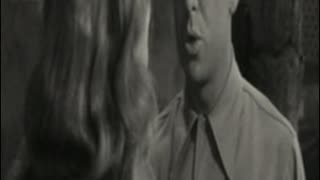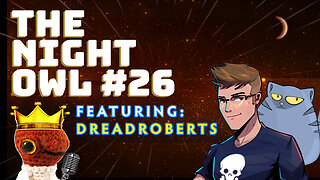"A haunting, atmospheric thriller that features mesmerizing performances" - Scarlet Street (1945)
Scarlet Street is a 1945 film noir directed by Fritz Lang and starring Edward G. Robinson, Joan Bennett, and Dan Duryea. The film tells the story of Christopher Cross (Robinson), a middle-aged cashier and amateur painter who falls in love with Kitty March (Bennett), a young woman he meets on the streets of New York City. However, Kitty is not interested in Christopher romantically and instead manipulates him into giving her money and presents.
As Christopher becomes more and more obsessed with Kitty, he begins embezzling money from his employer in order to fund her lavish lifestyle. Meanwhile, Kitty is secretly having an affair with Johnny (Duryea), a con artist who sees Christopher as an easy target. When Christopher finds out about the affair, he becomes enraged and confronts Johnny, leading to a violent confrontation.
Throughout the film, Lang employs a variety of film noir techniques, including moody lighting, shadowy cinematography, and a sense of impending doom. The film explores themes of love, obsession, and betrayal, as well as the corrupting influence of greed and desire. Scarlet Street is widely regarded as one of Fritz Lang's best films and is considered a classic of the film noir genre.
Scarlet Street is a 1945 American film noir directed by Fritz Lang. The screenplay concerns two criminals who take advantage of a middle-aged painter in order to steal his artwork. The film is based on the French novel La Chienne (literally The Bitch) by Georges de La Fouchardière, which had been previously dramatized on stage by André Mouëzy-Éon, and cinematically as La Chienne (1931) by director Jean Renoir.[2]
The principal actors Edward G. Robinson, Joan Bennett and Dan Duryea had earlier appeared together in The Woman in the Window (1944), also directed by Lang. Local authorities in New York, Milwaukee, and Atlanta banned Scarlet Street early in 1946 because of its dark plot and themes.[3]
The film is in the public domain.[4][5]
Plot
New York, 1934 – Christopher "Chris" Cross, a meek amateur painter and cashier for a clothing retailer, is fêted by his employer for 25 years of service. After presenting Chris with a gold watch and kind words, company head J.J. Hogarth leaves the party and gets into a car with a beautiful blonde. Chris muses to a colleague about his desire to be loved by a young woman like that.
Walking home through Greenwich Village, Chris sees a young woman, Katherine "Kitty" March, being attacked, and knocks her assailant unconscious with his umbrella. After Chris dashes off to summon a policeman, the assailant, who is actually Kitty's boyfriend Johnny, flees. Chris walks Kitty to her apartment. His wistful remarks about art suggest to her that Chris must be a wealthy painter. Enamored of Kitty and thinking she feels affection for him, Chris tells her about his loveless marriage. His shrewish wife Adele idolizes her previous husband, a policeman believed drowned while trying to rescue a suicidal woman.
Needing funds for a shady business deal, Johnny believes that Kitty should play on Chris's naivete and feign romantic interest in the supposed rich artist to swindle money from him. Kitty persuades Chris to rent her an apartment, suggesting that he could use it as his art studio. To finance the apartment, Chris steals $500 in insurance bonds from his wife and later $1,000 cash from his employer.
Unknown to Chris, Johnny tries selling some of his paintings, leaving them with a street vendor who thinks them worth no more than $25. The paintings attract the interest of art critic David Janeway, who declares the work as exceptional. After Johnny persuades Kitty to pretend that she painted them, she charms Janeway with Chris's own views about art. Captivated by the paintings and by Kitty, Janeway promises to represent her. However, Adele sees her husband's paintings, signed "Katherine March", in the window of a commercial art gallery and accuses Chris of copying March's work. Chris confronts Kitty, who claims that she had sold them because she needed the money. Delighted that his creations are appreciated, he lets her become the public face of his art. She becomes a huge commercial success, although Chris never receives any of the money.
Adele's supposedly dead first husband Higgins appears at Chris's office to extort money from him. Higgins did not drown but disappeared after stealing $2,700 from the purse of the woman whom he had tried to save. Already suspected of taking bribes from speakeasies, he faked his death to escape his crimes and his wife. Chris steals another $200 from the safe at work for Higgins. Chris plots for Adele to see Higgins, hoping that his marriage will be invalidated when Adele realizes that Higgins is still alive.
Chris goes to see Kitty, believing that he is now free and that she will marry him. He finds Johnny and Kitty in an embrace, confirming his suspicions that they are romantically involved. However, Chris asks Kitty to marry him, but she spurns him for being old and ugly and laughs in his face. Enraged, he stabs her to death with an ice pick. The police visit Chris's office. Higgins has told them that Chris embezzled money from Hogarth, who refuses to press charges, but fires Chris. Johnny is arrested for Kitty's murder.
At the trial, Johnny's past works against him. Chris denies painting the pictures, claiming to be an untalented artist. Several witnesses confirm Chris's testimony and attest to Johnny's misdeeds and bad character. Johnny is convicted and put to death for Kitty's murder, Chris goes unpunished and Kitty is erroneously immortalized as a great artist. Haunted by the murder, Chris attempts to hang himself on the night of Johnny's execution, but is rescued. Five years later, Chris is homeless and destitute, with no way of claiming credit for his own paintings. He witnesses his portrait of Kitty sell for $10,000. Tormented by thoughts of Kitty and Johnny loving each other eternally, Chris wanders New York, constantly hearing their voices in his mind.
Cast
Edward G. Robinson as Christopher Cross
Joan Bennett as Katherine 'Kitty' March
Dan Duryea as Johnny Prince
Margaret Lindsay as Millie Ray
Rosalind Ivan as Adele Cross
Jess Barker as David Janeway
Charles Kemper as Patch-eye Higgins
Anita Sharp-Bolster as Mrs. Michaels (as Anita Bolster)
Samuel S. Hinds as Charles Pringle
Vladimir Sokoloff as Pop LeJon
Arthur Loft as Delarowe
Russell Hicks as J.J. Hogarth
Production
1:42:04
Scarlet Street
Scarlet Street reunited director Fritz Lang with actors Edward G. Robinson, Joan Bennett and Dan Duryea, who had worked with him in The Woman in the Window (1944). The film was based on the French novel La Chienne (literally The Bitch) by Georges de La Fouchardière, which had been dramatized on stage by André Mouëzy-Éon, and cinematically as La Chienne (1931) by director Jean Renoir. Lang's film Human Desire (1954) was based on another Renoir film, La Bête humaine (1938), which was based on Émile Zola's novel on the same name. Renoir was said to have disliked both of Lang's films.
Scarlet Street is similar to The Woman in the Window in its themes, cast, crew and characters. Robinson again plays a lonely middle-aged man, and Bennett and Duryea once more play the criminal elements. Both films were photographed by Milton R. Krasner. Walter Wanger, who produced the film, had earlier produced Lang's 1937 film You Only Live Once.
Though Scarlet Street is considered a film noir classic along with Lang's earlier film The Woman in the Window, Robinson, who noticed the thematic similarities between the two, found the production of Scarlet Street monotonous and was eager to finish it and move on to other projects. Robinson had also disliked making The Woman in the Window.
Twelve paintings created for the film by John Decker were sent to the Museum of Modern Art in New York City for exhibition in March 1946.
Reception
Box office
According to Variety, the film earned rentals of $2.5 million in the U.S.[6]
Reception
Joan Bennett as Kitty March
New York Times film critic Bosley Crowther gave the film a mixed review. He wrote:
But for those who are looking for drama of a firm and incisive sort, Scarlet Street is not likely to furnish a particularly rare experience. Dudley Nichols wrote the story from a French original, in which it might well have had a stinging and grisly vitality. In this presentation, however, it seems a sluggish and manufactured tale, emerging much more from sheer contrivance than from the passions of the characters involved. And the slight twist of tension which tightens around the principal character is lost in the middle of the picture when he is shelved for a dull stretch of plot. In the role of the love-blighted cashier Edward G. Robinson performs monotonously and with little illumination of an adventurous spirit seeking air. And, as the girl whom he loves, Joan Bennett is static and colorless, completely lacking the malevolence that should flash in her evil role. Only Dan Duryea as her boy friend hits a proper and credible stride, making a vicious and serpentine creature out of a cheap, chiseling tinhorn off the streets.[7]
A review in Variety magazine stated: "Fritz Lang's production and direction ably project the sordid tale of the romance between a milquetoast character and a gold-digging blonde ... Edward G. Robinson is the mild cashier and amateur painter whose love for Joan Bennett leads him to embezzlement, murder and disgrace. Two stars turn in top work to keep the interest high, and Dan Duryea's portrayal of the crafty and crooked opportunist whom Bennett loves is a standout in furthering the melodrama."[8]
Time magazine gave Scarlet Street a negative review, describing the plot as clichéd and with dimwitted, unethical, stock characters.[9]
Critic Dennis Schwartz wrote in 2003:
Scarlet Street is a bleak psychological film noir that has the same leading actors as his 1944 film The Woman in the Window. It sets a long-standing trend of a criminal not punished for his crime; this is the first Hollywood film where that happened ... The Edward G. Robinson character is viewed as an ordinary man who is influenced by an evil couple who take advantage of his vulnerability and lead him down an amoral road where he eventually in a passionate moment loses his head and commits murder. Chris's imagination can no longer save him from his dreadful existence, and his complete downfall comes about as the talented artist loses track of reality and his dignity.[10]
Joan Bennett and Edward G. Robinson
In 1995, Matthew Bernstein wrote in Cinema Journal: "The film is a dense, well-structured film noir and has been analyzed and interpreted numerous times. Some of the earliest interpretations came from censors in three different cities," adding:
On January 4, 1946, the New York State Censor Board banned Scarlet Street entirely, relying on the statute that gave it power to censor films that were "obscene, indecent, immoral, inhuman, sacrilegious" or whose exhibition "would tend to corrupt morals or incite to crime." As if in a chain reaction, one week later the Motion Picture Commission for the city of Milwaukee also banned the film as part of a new policy encouraged by police for "stricter regulation of undesirable films." On February 3 Christina Smith, the city censor of Atlanta, argued that because of "the sordid life it portrayed, the treatment of illicit love, the failure of the characters to receive orthodox punishment from the police, and because the picture would tend to weaken a respect for the law," Scarlet Street was "licentious, profane, obscure and contrary to the good order of the community."... Universal was discouraged from challenging the constitutionality of the censors by the protests of the national religious groups that arose as the Atlanta case went to court.[11]
In 1998, Jonathan Rosenbaum of the Chicago Reader included the film in his unranked list of the best American films not included on the AFI Top 100.[12]
https://en.wikipedia.org/wiki/Scarlet_Street
"A stunning masterpiece of film noir, Scarlet Street is a haunting, atmospheric thriller that features mesmerizing performances from its talented cast and an intricate, gripping plot." - Rotten Tomatoes
"Lang's direction is top-notch, creating a sense of foreboding that permeates every scene. Robinson delivers one of his finest performances as the tragic Christopher, while Bennett and Duryea are both excellent as the deceitful Kitty and Johnny." - Roger Ebert
"Scarlet Street is a work of art. The film is full of suspense and intrigue, and the characters are complex and fascinating. It's a dark, brooding masterpiece that keeps you on the edge of your seat until the very end." - The Guardian
"Fritz Lang's Scarlet Street is a gripping, harrowing tale of love, lust, and betrayal that will keep you hooked from start to finish. The film is a testament to Lang's mastery of the film noir genre and remains a classic to this day." - Empire
"Edward G. Robinson's performance is nothing short of extraordinary. He imbues Christopher with a sense of tragic pathos that is both heartbreaking and unforgettable." - New York Times
Scarlet Street is a 1945 American film noir directed by Fritz Lang. The screenplay concerns two criminals who take advantage of a middle-aged painter in order to steal his artwork. The film is based on the French novel La Chienne (literally The Bitch) by Georges de La Fouchardière, which had been previously dramatized on stage by André Mouëzy-Éon, and cinematically as La Chienne (1931) by director Jean Renoir.[2]
The principal actors Edward G. Robinson, Joan Bennett and Dan Duryea had earlier appeared together in The Woman in the Window (1944), also directed by Lang. Local authorities in New York, Milwaukee, and Atlanta banned Scarlet Street early in 1946 because of its dark plot and themes.[3]
The film is in the public domain.[4][5]
Plot
New York, 1934 – Christopher "Chris" Cross, a meek amateur painter and cashier for a clothing retailer, is fêted by his employer for 25 years of service. After presenting Chris with a gold watch and kind words, company head J.J. Hogarth leaves the party and gets into a car with a beautiful blonde. Chris muses to a colleague about his desire to be loved by a young woman like that.
Walking home through Greenwich Village, Chris sees a young woman, Katherine "Kitty" March, being attacked, and knocks her assailant unconscious with his umbrella. After Chris dashes off to summon a policeman, the assailant, who is actually Kitty's boyfriend Johnny, flees. Chris walks Kitty to her apartment. His wistful remarks about art suggest to her that Chris must be a wealthy painter. Enamored of Kitty and thinking she feels affection for him, Chris tells her about his loveless marriage. His shrewish wife Adele idolizes her previous husband, a policeman believed drowned while trying to rescue a suicidal woman.
Needing funds for a shady business deal, Johnny believes that Kitty should play on Chris's naivete and feign romantic interest in the supposed rich artist to swindle money from him. Kitty persuades Chris to rent her an apartment, suggesting that he could use it as his art studio. To finance the apartment, Chris steals $500 in insurance bonds from his wife and later $1,000 cash from his employer.
Unknown to Chris, Johnny tries selling some of his paintings, leaving them with a street vendor who thinks them worth no more than $25. The paintings attract the interest of art critic Damon Janeway, who declares the work as exceptional. After Johnny persuades Kitty to pretend that she painted them, she charms Janeway with Chris's own views about art. Captivated by the paintings and by Kitty, Janeway promises to represent her. However, Adele sees her husband's paintings, signed "Katherine March", in the window of a commercial art gallery and accuses Chris of copying March's work. Chris confronts Kitty, who claims that she had sold them because she needed the money. Delighted that his creations are appreciated, he lets her become the public face of his art. She becomes a huge commercial success, although Chris never receives any of the money.
Adele's supposedly dead first husband Higgins appears at Chris's office to extort money from him. Higgins did not drown but disappeared after stealing $2,700 from the purse of the woman whom he had tried to save. Already suspected of taking bribes from speakeasies, he faked his death to escape his crimes and his wife. Chris steals another $200 from the safe at work for Higgins. Chris plots for Adele to see Higgins, hoping that his marriage will be invalidated when Adele realizes that Higgins is still alive.
Chris goes to see Kitty, believing that he is now free and that she will marry him. He finds Johnny and Kitty in an embrace, confirming his suspicions that they are romantically involved. However, Chris asks Kitty to marry him, but she spurns him for being old and ugly and laughs in his face. Enraged, he stabs her to death with an ice pick. The police visit Chris's office. Higgins has told them that Chris embezzled money from Hogarth, who refuses to press charges, but fires Chris. Johnny is arrested for Kitty's murder.
At the trial, Johnny's past works against him. Chris denies painting the pictures, claiming to be an untalented artist. Several witnesses confirm Chris's testimony and attest to Johnny's misdeeds and bad character. Johnny is convicted and put to death for Kitty's murder, Chris goes unpunished and Kitty is erroneously immortalized as a great artist. Haunted by the murder, Chris attempts to hang himself on the night of Johnny's execution, but is rescued. Five years later, Chris is homeless and destitute, with no way of claiming credit for his own paintings. He witnesses his portrait of Kitty sell for $10,000. Tormented by thoughts of Kitty and Johnny loving each other eternally, Chris wanders New York, constantly hearing their voices in his mind.
Cast
Edward G. Robinson as Christopher "Chris" Cross
Joan Bennett as Katherine "Kitty" March
Dan Duryea as Johnny Prince
Margaret Lindsay as Millie Ray
Rosalind Ivan as Adele Cross
Jess Barker as Damon Janeway
Charles Kemper as Patch-eye Higgins
Anita Sharp-Bolster as Mrs. Michaels (as Anita Bolster)
Samuel S. Hinds as Charles Pringle
Vladimir Sokoloff as Pop LeJon
Arthur Loft as Delarowe
Russell Hicks as J.J. Hogarth
Production
1:42:04
Scarlet Street
Scarlet Street reunited director Fritz Lang with actors Edward G. Robinson, Joan Bennett and Dan Duryea, who had worked with him in The Woman in the Window (1944). The film was based on the French novel La Chienne (literally The Bitch) by Georges de La Fouchardière, which had been dramatized on stage by André Mouëzy-Éon, and cinematically as La Chienne (1931) by director Jean Renoir. Lang's film Human Desire (1954) was based on another Renoir film, La Bête humaine (1938), which was based on Émile Zola's novel on the same name. Renoir was said to have disliked both of Lang's films.
Scarlet Street is similar to The Woman in the Window in its themes, cast, crew and characters. Robinson again plays a lonely middle-aged man, and Bennett and Duryea once more play the criminal elements. Both films were photographed by Milton R. Krasner. Walter Wanger, who produced the film, had earlier produced Lang's 1937 film You Only Live Once.
Though Scarlet Street is considered a film noir classic along with Lang's earlier film The Woman in the Window, Robinson, who noticed the thematic similarities between the two, found the production of Scarlet Street monotonous and was eager to finish it and move on to other projects. Robinson had also disliked making The Woman in the Window.
Twelve paintings created for the film by John Decker were sent to the Museum of Modern Art in New York City for exhibition in March 1946.
Reception
Box office
According to Variety, the film earned rentals of $2.5 million in the U.S.[6]
Reception
Joan Bennett as Kitty March
New York Times film critic Bosley Crowther gave the film a mixed review. He wrote:
But for those who are looking for drama of a firm and incisive sort, Scarlet Street is not likely to furnish a particularly rare experience. Dudley Nichols wrote the story from a French original, in which it might well have had a stinging and grisly vitality. In this presentation, however, it seems a sluggish and manufactured tale, emerging much more from sheer contrivance than from the passions of the characters involved. And the slight twist of tension which tightens around the principal character is lost in the middle of the picture when he is shelved for a dull stretch of plot. In the role of the love-blighted cashier Edward G. Robinson performs monotonously and with little illumination of an adventurous spirit seeking air. And, as the girl whom he loves, Joan Bennett is static and colorless, completely lacking the malevolence that should flash in her evil role. Only Dan Duryea as her boy friend hits a proper and credible stride, making a vicious and serpentine creature out of a cheap, chiseling tinhorn off the streets.[7]
A review in Variety magazine stated: "Fritz Lang's production and direction ably project the sordid tale of the romance between a milquetoast character and a gold-digging blonde ... Edward G. Robinson is the mild cashier and amateur painter whose love for Joan Bennett leads him to embezzlement, murder and disgrace. Two stars turn in top work to keep the interest high, and Dan Duryea's portrayal of the crafty and crooked opportunist whom Bennett loves is a standout in furthering the melodrama."[8]
Time magazine gave Scarlet Street a negative review, describing the plot as clichéd and with dimwitted, unethical, stock characters.[9]
Critic Dennis Schwartz wrote in 2003:
Scarlet Street is a bleak psychological film noir that has the same leading actors as his 1944 film The Woman in the Window. It sets a long-standing trend of a criminal not punished for his crime; this is the first Hollywood film where that happened ... The Edward G. Robinson character is viewed as an ordinary man who is influenced by an evil couple who take advantage of his vulnerability and lead him down an amoral road where he eventually in a passionate moment loses his head and commits murder. Chris's imagination can no longer save him from his dreadful existence, and his complete downfall comes about as the talented artist loses track of reality and his dignity.[10]
Joan Bennett and Edward G. Robinson
In 1995, Matthew Bernstein wrote in Cinema Journal: "The film is a dense, well-structured film noir and has been analyzed and interpreted numerous times. Some of the earliest interpretations came from censors in three different cities," adding:
On January 4, 1946, the New York State Censor Board banned Scarlet Street entirely, relying on the statute that gave it power to censor films that were "obscene, indecent, immoral, inhuman, sacrilegious" or whose exhibition "would tend to corrupt morals or incite to crime." As if in a chain reaction, one week later the Motion Picture Commission for the city of Milwaukee also banned the film as part of a new policy encouraged by police for "stricter regulation of undesirable films." On February 3 Christina Smith, the city censor of Atlanta, argued that because of "the sordid life it portrayed, the treatment of illicit love, the failure of the characters to receive orthodox punishment from the police, and because the picture would tend to weaken a respect for the law," Scarlet Street was "licentious, profane, obscure and contrary to the good order of the community."... Universal was discouraged from challenging the constitutionality of the censors by the protests of the national religious groups that arose as the Atlanta case went to court.[11]
In 1998, Jonathan Rosenbaum of the Chicago Reader included the film in his unranked list of the best American films not included on the AFI Top 100.[12]
See also
Public domain film
List of American films of 1945
List of films in the public domain in the United States
References
Matthew Bernstein, Walter Wagner: Hollywood Independent, Minnesota Press, 2000 p443
Scarlet Street at IMDb
Matthew Bernstein, "A Tale of Three Cities: The Banning of Scarlet Street". Cinema Journal (Autumn 1995), 27-52.
Rapold, Nicolas (14 February 2014). "Even Good Films May Go to Purgatory: Old Films Fall Into Public Domain Under Copyright Law". The New York Times. Retrieved 10 March 2018.
Murray, Noel (23 November 2005). "Scarlet Street & House By The River". The A.V. Club. Retrieved 10 March 2018.
"60 Top Grossers of 1946", Variety 8 January 1947 p8
Crowther, Bosley. The New York Times, film review, February 15, 1946. Last accessed: April 11, 2008.
Variety. Film review, 1945. Last accessed: April 11, 2008.
Cinema: The New Pictures, Jan. 21, 1946
Schwartz, Dennis "An uncompromising subversive remake of Jean Renoir's La Chienne (1931)". Film review at Ozus' World Movie Reviews, February 13, 2003. Accessed: June 20, 2013.
Bernstein, Matthew (Autumn 1995). "A Tale of Three Cities: The Banning of Scarlet Street". Cinema Journal. 35 (1): 27–52. doi:10.2307/1225806. JSTOR 1225806., pp. 27-52.
Rosenbaum, Jonathan (June 25, 1998). "List-o-Mania: Or, How I Stopped Worrying and Learned to Love American Movies". Chicago Reader. Archived from the original on April 13, 2020.
External links
Wikiquote has quotations related to Scarlet Street.
Wikimedia Commons has media related to Scarlet Street.
Scarlet Street at IMDb
Scarlet Street at AllMovie
Scarlet Street at the TCM Movie Database
Scarlet Street at the American Film Institute Catalog
Scarlet Street is available for free download at the Internet Archive
Scarlet Street, Full Movie on YouTube
vte
Films directed by Fritz Lang
vte
Films produced by Walter Wanger
vte
Films by Dudley Nichols
Categories:
1945 films1945 crime drama filmsAmerican black-and-white filmsAmerican crime drama filmsAmerican films based on playsAmerican remakes of French films1940s English-language filmsFilm noirFilms about fictional paintersFilms based on adaptationsFilms based on French novelsFilms directed by Fritz LangFilms produced by Walter WangerFilms scored by Hans J. SalterFilms set in 1934Films set in New York CityFilms with screenplays by Dudley NicholsUniversal Pictures filmsCensored films1940s American films
-
 13:54
13:54
The Film Archives
1 year agoOld Hollywood Bloopers (1942)
533 -
 9:39
9:39
GeekyNerdyTechy
21 hours agoPanasonic LUMIX GH6 - Abandoned?
22.9K4 -
 16:12
16:12
NC Dirt Hunter
11 hours agoCivil War ground gives up its secrets! Metal Detecting with the Minelab Manticore
26.9K -
 1:04:53
1:04:53
ReasonTV
20 hours agoPhil Magness: Who Really Pays The Most Taxes?
31K15 -
 3:22:59
3:22:59
Rekieta Law
7 hours agoDaniel Perry Pardoned, Cohen Pressed, NFL Shaken, Clarence Thomas Grilled, ADL Most Affected
30.2K10 -
 2:15:57
2:15:57
Price of Reason
12 hours agoAmazon Wants FEMINIST Tomb Raider! Gaming DEI Agenda EXPOSED w/ Dreadroberts
25K7 -
 1:38:48
1:38:48
TheMonicaCrowleyPodcast
16 hours agoThe 2020 to 2024 Trek Clean Elections
33.9K16 -
 3:34:45
3:34:45
Akademiks
8 hours agoHappy Birthday Big AK. Lets bring it in together chat.
66.7K38 -
 1:28:57
1:28:57
The Charlie Kirk Show
11 hours agoTHOUGHTCRIME Ep. 44 — Is Doxxing Dead? Poo-Loving Libs? The Truth About Pearl Harbor?
88K53 -
 1:18:32
1:18:32
Kim Iversen
12 hours agoBig Pharma Hopes For Another Cash Cow Vaccine With Bird Flu GAIN OF FUNCTION Research
64.3K177